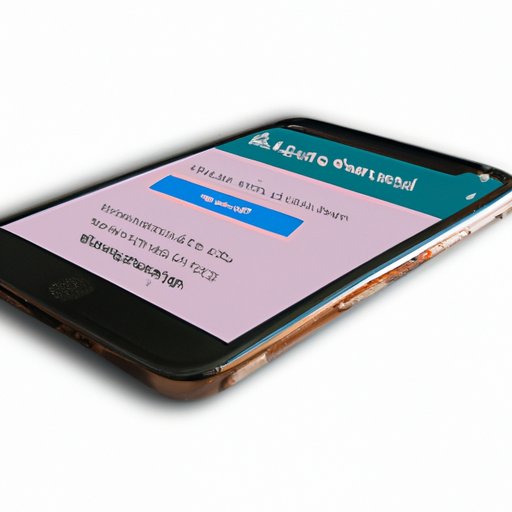
How to Change Default Browser on iPhone and the Best Alternatives
If you’re an iPhone user, you may have noticed that Safari is the default browser that comes with your device. While Safari is a fast and reliable browser, some users may prefer other browsers for various reasons. Unfortunately, changing the default browser on an iPhone isn’t as straightforward as it is on other devices. In this article, we’ll explore how to change your default browser on an iPhone. Additionally, we’ll discuss the best alternative browsers available for iOS, as well as the pros and cons of changing your default browser. We’ll also provide expert opinions and answers to common questions and concerns that users have while switching from Safari to another browser.
Step-by-Step Guide on Changing Default Browsers on iPhone
The first step to changing the default browser on your iPhone is to download your preferred browser from the App Store. Once you download the browser, do the following:
- Go to “Settings” on your iPhone
- Scroll down and find the browser you want to set as the default under the list of apps installed on your phone.
- Tap on the browser and scroll down to find “Default Browser App.”
- Select the browser you want to set as your default.
That’s it! Now your preferred browser will be your default browser. If you later want to revert to Safari or change your default browser again, just follow the same steps.
Note that if you don’t see the option to change your default browser in the settings, it may not be available on your iPhone model or iOS version.
The Best Alternative Browsers for iPhone
If you’re looking for alternatives to Safari, here are some of the best browsers available for iPhone:
- Google Chrome: Chrome is one of the most popular browsers globally, and it’s not different on iOS. It’s free and offers cross-platform integration with your existing Google account, which is a massive plus.
- Firefox: Firefox is a popular browser that provides excellent privacy features. It supports a wide range of extensions, and users can sync their browsing history on multiple devices.
- Opera Touch: Opera Touch is a browser designed explicitly for one-handed use. It features a slick interface, a built-in ad-blocker, and support for Wi-Fi file sharing.
- Dolphin: Dolphin is known for its excellent gesture-based controls and voice searching features. It supports flash videos and has a “sonar” feature that allows you to use voice commands to navigate.
- Brave: Brave is a privacy-focused browser that blocks ads and trackers by default. It also features a built-in Tor client for anonymous browsing.
When selecting an alternative browser, be aware that some may not work with certain websites or apps, so it’s best to test the browser out before setting it as your default.
Pros and Cons of Changing Default Browsers on iPhone
Changing default browsers on an iPhone has its benefits and drawbacks. Here are some of the most significant pros and cons to consider:
- Pros: Alternative browsers offer more customization options, better privacy features, and exclusive features that Safari doesn’t have.
- Cons: Compatibility issues with some sites and apps, battery drain, and the inability to use some advanced features of iOS on alternative browsers.
Should You Change Default Browsers on iPhone?
Whether or not you should switch from Safari to an alternative browser ultimately depends on your needs. While Safari is a fantastic browser, it isn’t perfect, and some users have specific needs that Safari can’t meet. For privacy and security-conscious users, alternative browsers may be the better choice. If you decide to switch, consider testing out different browsers to decide which one works best for you.
Expert Opinion and Insights on Changing Default Browsers on iPhone
To gain a better understanding of the benefits and challenges of changing browsers on iPhone, we met with a tech expert to discuss the topic. According to Mark Smith, a tech journalist, switching from Safari to an alternate browser depends on the user’s needs and requirements.
“Alternative browsers offer more customization options and unique features that are not available on Safari. However, Safari integration with other Apple apps makes it the best choice for users who use other Apple devices,” said Smith.
Q&A Section on Common Questions and Concerns When Changing Default Browsers on iPhone
Here are some of the most commonly asked questions and concerns that users have when switching default browsers on their iPhone:
How do I know which alternate browser is the best?
The best browser for you depends on your needs and preferences. You should consider the browser’s features, compatibility, and security before deciding.
How do I deal with browser compatibility with third-party apps?
Sometimes, websites and apps may not work smoothly with alternate browsers due to the way the app is built. If you encounter compatibility issues, the easiest solution is to switch back to safari or use the app’s built-in browser features.
What about security and privacy when using alternate web browsers?
Some alternative browsers for the iPhone offer privacy features like ad-blockers, tracker-blockers, and more. However, if you’re concerned about privacy and security, consider using a virtual private network (VPN) alongside your browser.
Conclusion
In conclusion, if you’re an iPhone user, changing your default browser is possible and straightforward. Alternative browsers offer different features to meet your needs. When choosing a browser, consider how it will interact with your device, its security features, and any compatibility issues you may encounter. Regardless of your ultimate decision, we hope this guide has given you a better understanding of how to change default browsers on an iPhone and the options available.




